Adirondack Wildlife:
Amphibians and Reptiles of the Adirondack Park
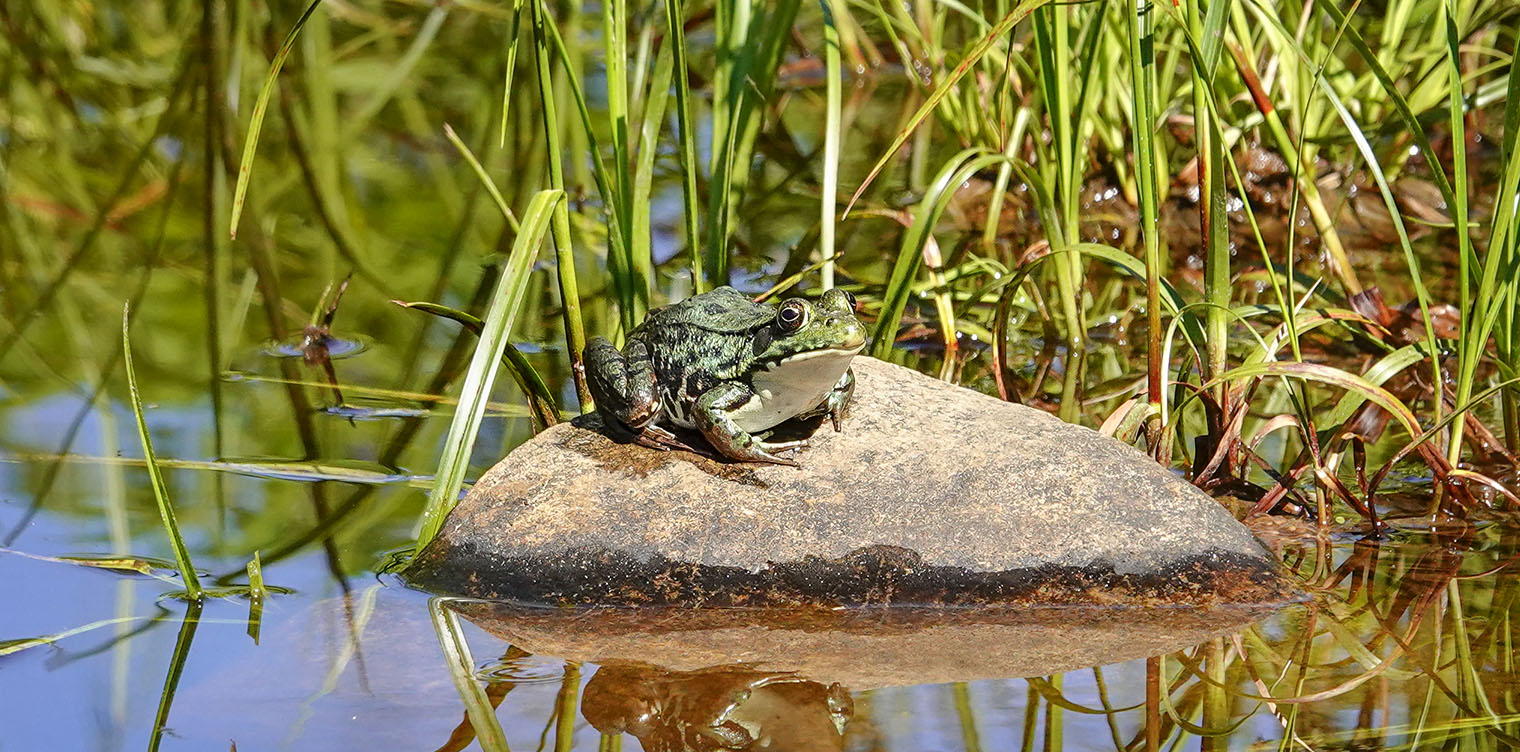
New York State is host to 69 species of amphibians and reptiles, including 18 species of salamanders, 14 species of frogs and toads, 17 turtle species, 3 species of lizard, and 17 species of snakes. Of these, 39 species occur in the Adirondack region, including seven amphibian families and six families of reptiles.
Both amphibians and reptiles are ectothermicEctothermic: Refers to animals that are cold-blooded – an animal that regulates its temperature behaviorally by means of outside sources of heat. Ectotherms include fishes, reptiles, amphibians, and invertebrates. By contrast, endotherms are organisms that maintain their body temperature largely by internal bodily functions. Birds and mammals are endotherms. , meaning that they obtain body heat from sources outside their bodies. In order to get warm enough to become active, amphibian and reptiles must position themselves in the environment to obtain heat or remain inactive for long periods. There are, however, important differences:
- Amphibians are dependent on both land and water. They have moist, permeable skin used for both water and oxygen intake; they produce gelatinous eggs that must be kept moist until hatching. Amphibians must remain in moist environments and return to water to breed. Their eggs are produced in great numbers, usually in shallow water. The eggs hatch as small tadpoles with external gills and later undergo a metamorphosis into an adult with four legs, capable of life on land. Adirondack amphibians include 11 salamander species and nine species of frogs and toads.
- Reptiles are more closely related to birds and mammals than to modern amphibians. They have dry, scaly skin which is impermeable to water and respire primarily through their lungs. Turtles produce relatively few eggs with a leathery shell protecting the developing embryo, laying the eggs in dry, sandy soil on land. Snakes either lay eggs or give birth to live young. Reptiles native to the Adirondack region include 5 species of turtle, 11 species of snakes, and a single lizard species (the Five-lined Skink).
Adirondack Amphibians: Salamanders
Adirondack Salamanders
- Allegheny Mountain Dusky Salamander (Desmognathus ochrophaeus)
- Blue-spotted Salamander (Ambystoma laterale)
- Eastern Newt (Notophthalmus viridescens)
- Eastern Red-backed Salamander (Plethodon cinereus)
- Four-toed Salamander (Hemidactylium scutatum)
- Jefferson Salamander (Ambystoma jeffersonianum)
- Mudpuppy (Necturus maculosus)
- Northern Dusky Salamander (Desmognathus fuscus)
- Northern Two-Lined Salamander (Eurycea bislineata)
- Spotted Salamander (Ambystoma maculatum)
- Spring Salamander (Gyrinophilus porphyriticus)
Adirondack amphibians include four families of salamanders, encompassing 11 species. Most salamanders are nocturnal and spend their time in soil and fallen debris in mature forests and wooded streamsides. Salamanders are relatively long-lived (surviving a decade or more in the wild) and have complex life cycles that generally include three stages: egg, larva, and adult.
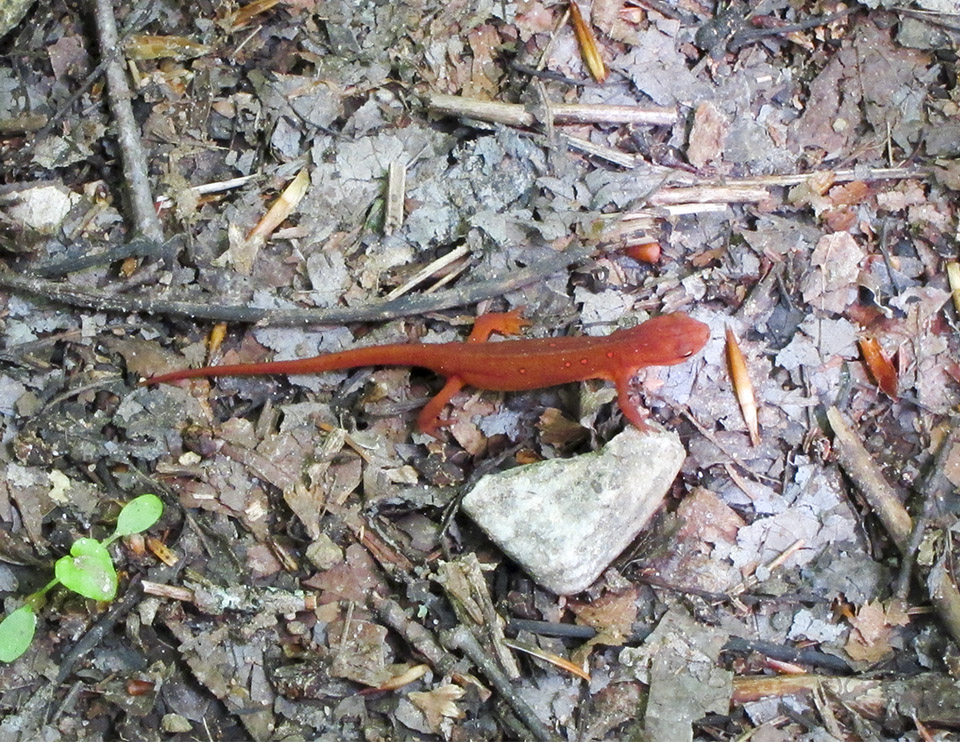
The Eastern Newt (Notophthalmus viridescens) is an interesting variation on this pattern. It has a more complex life cycle with four distinct life stages:
- The newt begins its life as an egg, deposited singly in submerged vegetation in a pond.
- The egg hatches into a larva, which uses gills to breathe and lives in water.
- The juvenile stage is terrestrial. This stage begins when the larva loses its gills and transforms into a Red Eft. Red Efts have orange skin with two rows of dark-rimmed spots on the back. This stage lasts two to seven years. The bright orange coloration is designed to advertise the eft's toxicity to potential predators. During this stage, the Red Eft may wander far from the location where it spent its larval stage.
- A second metamorphosis occurs when the eft transforms into a yellow to olive-green adult, with a dull yellow belly and a series of orange spots on its back. The adult develops a larger, blade-like tail and slimy skin and remains in or near a pond for the rest of its life. The adults are nearly fully aquatic, although some populations may spend much of their time on land, leaving their ponds in summer and not returning until the following spring.
Eastern Newts are carnivorous during all their life history stages. Aquatic larvae feed on insects and their larvae, particularly mayfly, caddisfly, midge, and mosquito larvae. The terrestrial Red Eft feeds on earthworms and arthropods found within leaf litter. Aquatic adults prey on aquatic insects, crustaceans, mollusks, and the eggs and larvae of other amphibians.
During the juvenile Red Eft stage, this amphibian is found on moist forest floors. Red Efts are typically found under leaf litter, brush piles, logs and stumps. They occur in forests of any type, but seem to prefer deciduous and mixed forests. Adults inhabit small bodies of fresh water, particularly water with abundant submerged vegetation, including ponds, lakes, deep emergent marshes, and slow-moving rivers.
Eastern Red-backed Salamanders (Plethodon cinereus) are also found in the Adirondack Park, although they are less common than Eastern Newts. Eastern Red-backed Salamanders are small terrestrial salamanders, with two color variations. One has a broad brick-red or orange stripe along the back; the darker variety has a dark, unstriped back. Both variants have speckled black and white bellies. The body is long and fairly slender.
Eastern Red-backed Salamanders are carnivorous. They feed on a wide variety of prey, including mites, earthworms, beetle and fly larvae, snails, slugs, millipedes, and spiders. They forage for their prey on both the surface of the ground and a foot or more off the forest floor on the branches of shrubs or on tree trunks. Eastern Red-backed Salamanders also serve as prey for many larger animals, including birds, snakes, small mammals, and larger salamanders.
Eastern Red-backed Salamanders are found in a wide variety of woodland settings, including deciduous, mixed, and northern conifer forests. However, they occur in the greatest densities in hardwood forests with a heavy canopy cover and a forest floor with abundant leaf litter, logs, and stones to provide cover and habitat for their prey.
Adirondack Amphibians: Frogs & Toads
Adirondack Frogs & Toads
- American Bullfrog (Lithobates catesbeiana)
- American Toad (Anaxyrus americanus)
- Gray Treefrog (Dryophytes versicolor)
- Green Frog (Lithobates clamitans)
- Mink Frog (Lithobates septentrionalis)
- Northern Leopard Frog (Lithobates pipiens)
- Pickerel Frog (Lithobates palustris)
- Spring Peeper (Pseudacris crucifer)
- Wood Frog (Lithobates sylvaticus)
Frogs are short-bodied, tailless amphibians that typically lay their eggs in water. The eggs hatch into aquatic larvae called tadpoles. Tadpoles undergo a metamorphosis into adults with large hind limbs, allowing them to jump for long distances. Adult frogs are generally carnivorous. Males of most species advertise their presence in the spring with mating calls that join the chorus of bird songs and calls.
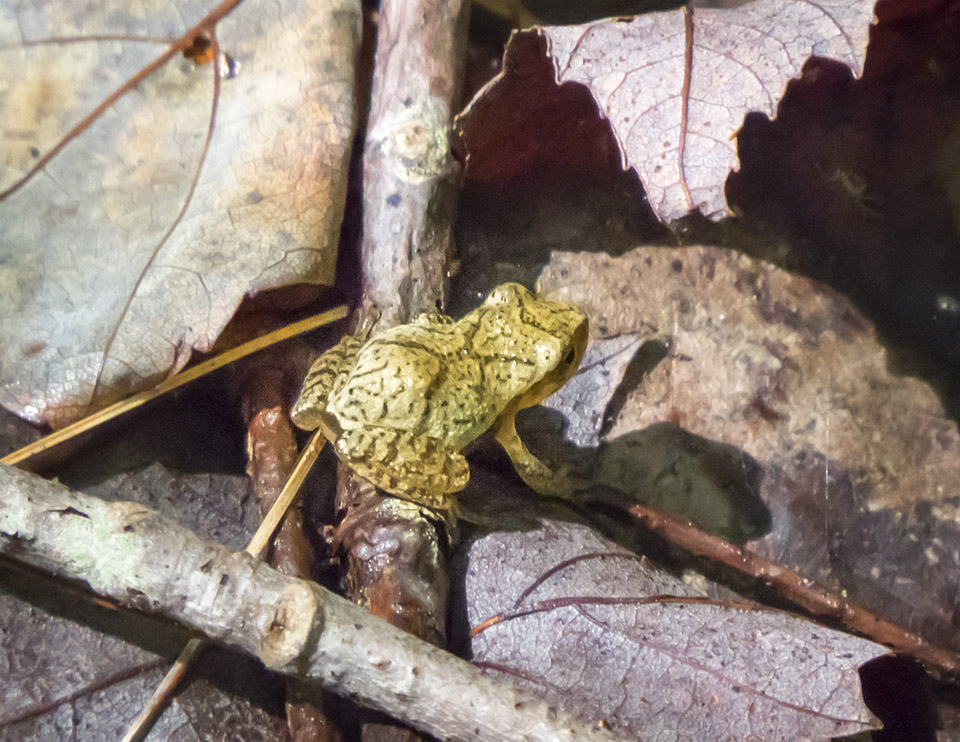
Perhaps the best-known call in our area is that of the Spring Peeper (Pseudacris crucifer). Only about an inch in length when fully grown, the Spring Peeper sports a characteristic "X" on its back. There is a dark patch surrounding the eye; the underside is cream-colored.
Spring Peepers spend the winter in a dormant state under layers of debris on the forest floor. As the ground warms in the spring, they trek off to pond edges, vernal pools, swamps, or marshes, where the males begin advertising their availability for breeding with a chorus of shrill, melodious (and sometimes deafening) peeps. This advertisement call is usually given 15-25 times per minute. Female Spring Peepers choose males based on call volume and rapidity. They extrude tiny eggs, which hatch into small, dark tadpoles.
After the spring breeding season, this tiny amphibian travels back into the nearby woods, where some sporadic peeping may be heard in fall, usually during a period of mild temperatures. The Spring Peeper's non-breeding habitats are diverse. They inhabit a wide variety of terrestrial communities, including hardwood, mixed, and conifer forests, meadows, and forested ravines, often areas in fairly close proximity to wetlands. Adult Spring Peepers are insectivores; they hunt in low vegetation, feeding primarily on small nonaquatic insects, such as ants, beetles, flies, spiders, and mites.
Another amphibian found in wooded areas of the Adirondack Park is the Gray Treefrog (Dryophytes versicolor), a small arboreal frog native to much of the eastern United States and southeastern Canada. The Gray Treefrog is not often seen, because it spends much of its time residing on branches and twigs above eye level, rather than on the forest floor. Moreover, this creature is equipped with a very effective protective camouflage. Normally gray or grayish green, the Gray Treefrog can vary its color, depending on its background – a strategy that makes it so inconspicuous that it is likely to be overlooked by passing trail walkers. The Gray Treefrog navigates through the branches using toes equipped with special suction-cup ends that allow it to attach itself to tree surfaces.
The Gray Treefrog occurs in mixed forests, but is found most frequently in moist deciduous woodlands, especially those near swamps and shrubby wetlands. The Gray Treefrog breeds in aquatic sites, especially semipermanent woodland ponds, swamps, and vernal pools.
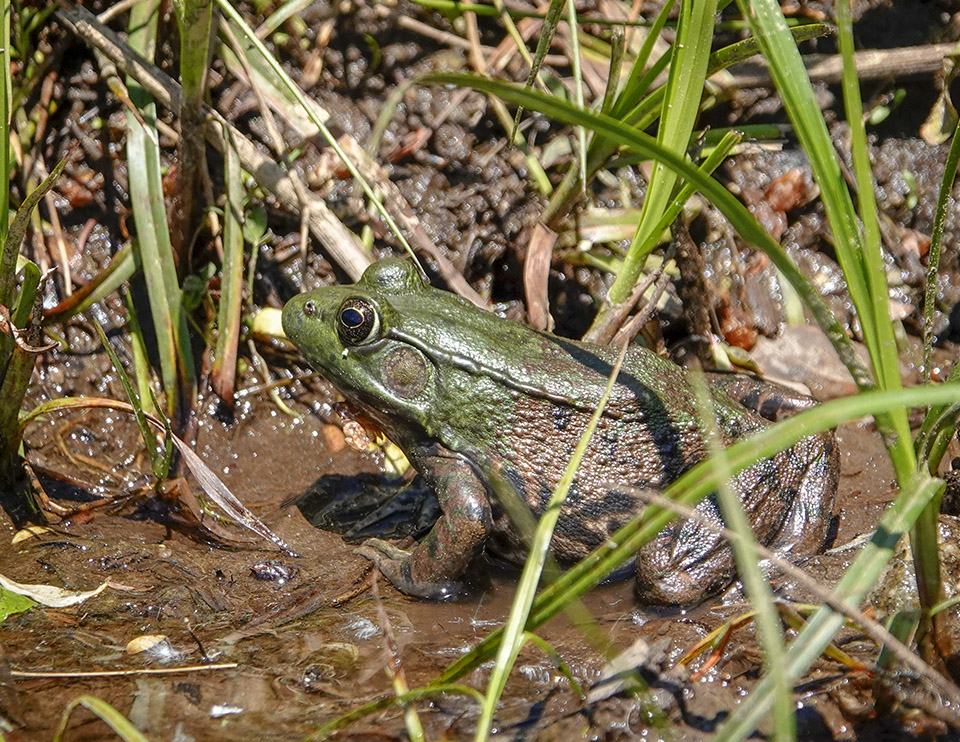
Green Frogs (Lithobates clamitans) are probably the most abundant frogs in the Adirondack region.
- Green Frogs are mid-sized frogs, ranging from about two to four inches in body length. Mature females are generally larger than males.
- Despite the name, not all Green Frogs are green; some are brown, bronze, or olive.
- These frogs have distinct eardrums and two prominent folds of skin (dorsolateral foldsDorsolateral Folds: Ridges of raised skin running down the sides of a frog's back. Many members of the Ranidae family have such folds.) that run partly down the back.
- The hind legs have dark banding.
Male Green Frogs begin calling in early May in our region. Its call is a staccato "gunk," similar to the sound of a loose banjo string being plucked. Females choose mates based mainly on the quality of egg-laying sites within the male's territory. The breeding season is fairly prolonged. Green Frogs can be heard calling through mid- to late July.
Green Frogs are aquatic frogs which rarely wander far from some a water source. They live in permanent waters, including ponds, marshes, creeks, fens, and moist woodlands. They overwinter in the muck at the bottom of wetland breeding sites.
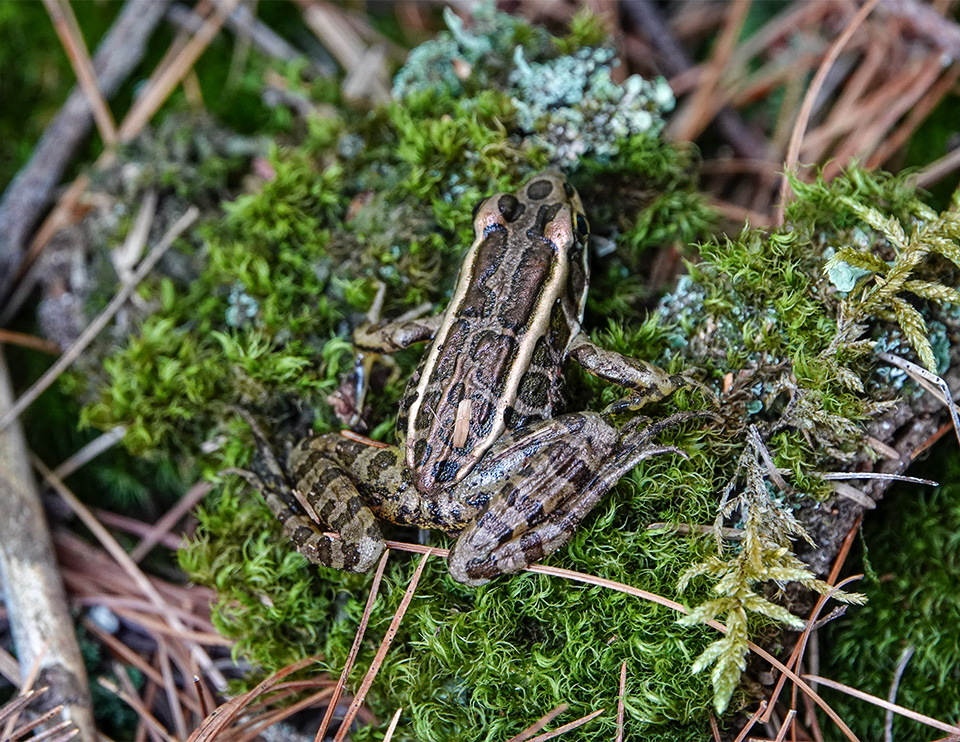
Pickerel Frogs (Lithobates palustris) are also found in the Adirondack Park, although they appear to be less common than Green Frogs. The Pickerel Frog is a medium-sized frog with several parallel rows of dark, squarish or rectangular spots running down the back between bronze dorsolateral foldsDorsolateral Folds: Ridges of raised skin running down the sides of a frog's back. Many members of the Ranidae family have such folds.. The Pickerel Frog is similar in appearance to the Northern Leopard Frog, which also occurs in the Adirondacks. However, the spots of the Northern Leopard Frog are round and occur in a more random pattern.
Pickerel Frogs breed in mid- to late spring in aquatic habitats, including woodland pools and ponds, floodplain wetlands, and marshes. During breeding season, Male Pickerel Frogs make a steady, low-pitched croak, often described as sounding like a snore, which lasts about two seconds. In our area, this species may be heard calling from early April to early July. Female Pickerel Frogs lay their eggs in shallow water, sometimes attached to twigs.
Pickerel Frogs are found in a wide variety of aquatic habitats near wooded areas. This species generally spends the summer away from water, often moving into grassy fields or herbaceous-covered areas. They overwinter in muck in the bottom of ponds or other water bodies.
Adirondack Reptiles: Turtles
Adirondack Turtles
- Blanding's Turtle (Emydoidea blandingii)
- Eastern Musk Turtle (Sternotherus odoratus)
- Northern Map Turtle (Graptemys geograpica)
- Painted Turtle (Chrysemys picta)
- Snapping Turtle (Chelydra serpentina)
- Spotted Turtle (Clemmys guttatta)
- Wood Turtle (Glyptemys insculpta)
Turtles are reptiles with a special bony shell that acts as a shield. Like other reptiles, turtles are ectothermsEctotherm: An animal that regulates its temperature behaviorally by means of outside sources of heat. Ectotherms (cold-blooded animals) include fishes, reptiles, amphibians, and invertebrates. By contrast, endotherms (warm-blooded animals) are organisms that maintain their body temperature largely by internal bodily functions. Birds and mammals are endotherms. , meaning that they regulate their temperature behaviorally by means of outside sources of heat. The Adirondack region hosts five species of turtles. Our turtles are largely aquatic; most spend much of their time in water, although (like all turtles) they lay their eggs on land.
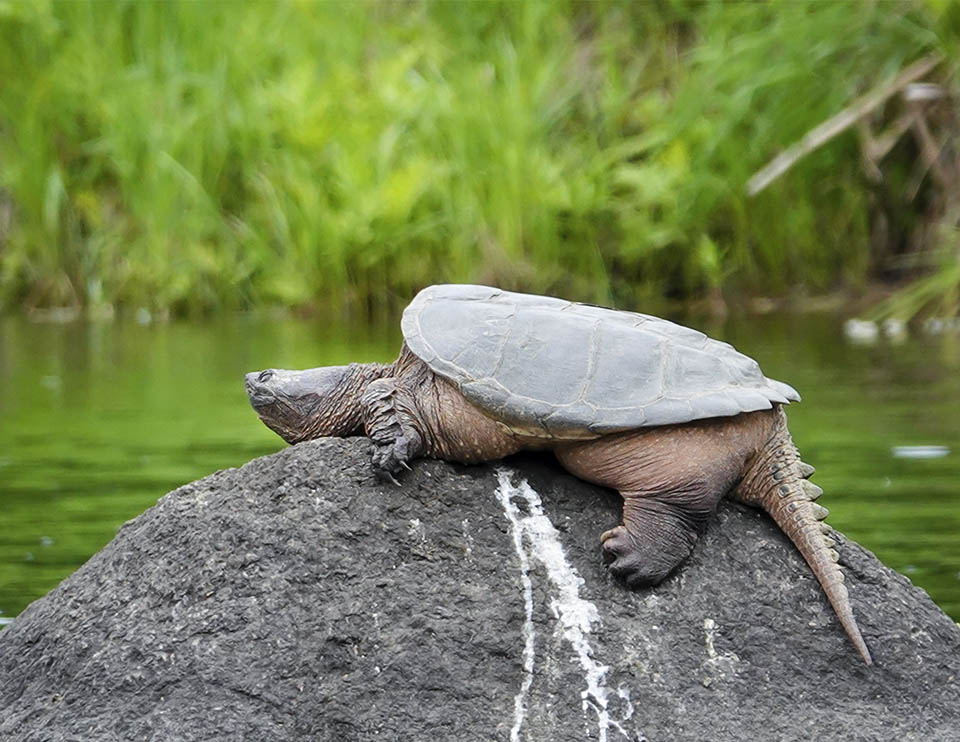
The Snapping Turtle is an example. These large, freshwater turtles have massive heads and powerful jaws. The carapaceCarapace: The dorsal (upper) section of the exoskeleton or shell in a number of animal groups, including arthropods (such as crustaceans and arachnids) and vertebrates (such as turtles and tortoises). In turtles and tortoises, the underside of the shell is called the plastron. (upper shell) is tan or olive to black and is often covered in algae. Their tiny plastronPlastron: The lower section of the turtle's shell. The upper section is called the carapace. (bottom shell) is yellowish. This turtle's long tail has a series of triangular spikes along the top. The shell length of the Snapping Turtle is 8 to 20 inches, with most individuals weighing in between 8 and 35 pounds.
Snapping Turtles are omnivores (meaning that they eat both plants and animals). Animal matter accounts for 54% of prey items and includes fish, crayfish, aquatic invertebrates, reptiles, birds (mainly young waterfowl), and fish (including suckers, bullheads, sunfish, and perch). Plant material makes up about 37% of their menu and includes mainly aquatics such as algae and the foliage or stems of waterweed, pondweeds, and waterlilies (such as White Water Lily and Yellow Pond Lily).
Snapping Turtles are widely distributed within the Adirondack Park. They spend much of the lives in aquatic habitats, including marshes, ponds, large lakes, reservoirs, and rivers. They prefer slow-moving water and tend to be most at home in shallow, marshy swamps with a soft mud bottom and submerged and emergent plants. Females travel overland in late spring, in search of suitable nesting areas to lay their eggs. Snapping Turtles overwinter on the muddy bottoms of water bodies, usually not too far from shore.
Painted Turtles are another commonly seen reptile in the Adirondack Park. The Painted Turtle (Chrysemys picta) is said to be the most widespread native turtle of North America. There are four subspecies; ours is the Midland Painted Turtle (Chrysemys picta marginata). Painted Turtles are smallish turtles, averaging 4½ to six inches in length. The carapaceCarapace: The dorsal (upper) section of the exoskeleton or shell in a number of animal groups, including arthropods (such as crustaceans and arachnids) and vertebrates (such as turtles and tortoises). In turtles and tortoises, the underside of the shell is called the plastron. (upper shell) of Painted Turtles is smooth and somewhat flattened, with red or dark orange markings on an olive to black background. This turtle also has red and yellow stripes on the neck, legs, and tail. The distinguishing feature of the Midland Painted Turtle is its lower shell (plastronPlastron: The lower section of the turtle's shell. The upper section is called the carapace.), which is yellow or dark tan with a darker, irregular butterfly marking along the midline.
Like Snapping Turtles, Painted Turtles eat both plants and animals. Their diet includes aquatic insects, snails, small fish, tadpoles, mussels, and carrion. Plant material (such as algae and cattails) constitutes about half of their diet.
Painted Turtles are found in creeks, marshes, ponds, and the shores of lakes. They prefer shallow water with slow-moving currents, basking sites, and aquatic vegetation. Painted Turtles are largely diurnal and are most commonly seen basking in the sunshine on logs and protruding logs, but they are quick to slide off their perches when humans approach. When freezing weather arrives in the autumn, Painted Turtles burrow into the mud or decayed vegetation of pond bottoms to avoid the cold.
Adirondack Reptiles: Skinks & Snakes
Adirondack Skinks & Snakes
- Common Five-lined Skink (Eumeces fasciatus)
- Common Gartersnake (Thamnophis sirtalis)
- Common Ribbonsnake (Thamnophis saurita saurita)
- Dekay's Brown Snake (Storeria dekayi)
- Eastern Milksnake (Lampropeltis triangulum)
- Eastern Ratsnake (Pantherophis alleghaniensis)
- North American Racer (Coluber constrictor)
- Northern Watersnake (Nerodia sipedon sipedon)
- Red-Bellied Snake (Storeria occipitomaculata)
- Ring-Necked Snake (Diadophis punctatus)
- Smooth Greensnake (Opheodrys vernalis)
- Timber Rattlesnake (Crotalus horridus)
Eleven snake species and one skink are native to the Adirondack Park. In response to our cold winters, snakes native to the Adirondack region retreat to burrows, rock piles, or the inside of fallen trees to spend the colder months in a state of winter dormancy known as brumationBrumation: A period of dormancy in which an animal becomes less physiologically active, growth stops, and metabolic processes slow down. Like hibernation, brumation in snakes is a way to cope with harsh winter weather. Both hibernation in mammals and brumation in reptiles is triggered by shortening day length and temperature changes. Both mammals preparing for hibernation and reptiles and amphibians preparing for dormancy eat more to build up fat reserves. However, in contrast to mammals in hibernation, who sleep during their dormancy period, snakes are not asleep and will take advantage of mild weather to venture out of their retreats and bask in the sun. An important feature of brumation is the snakes' need to drink and avoid dehydration.. Like all snakes, our snakes are carnivorous. Most locate their prey through scent. The Adirondack Park has only one venomous snake – the Timber Rattlesnake (Crotalus horridus), which is found only in a few isolated rocky areas near Lake George.
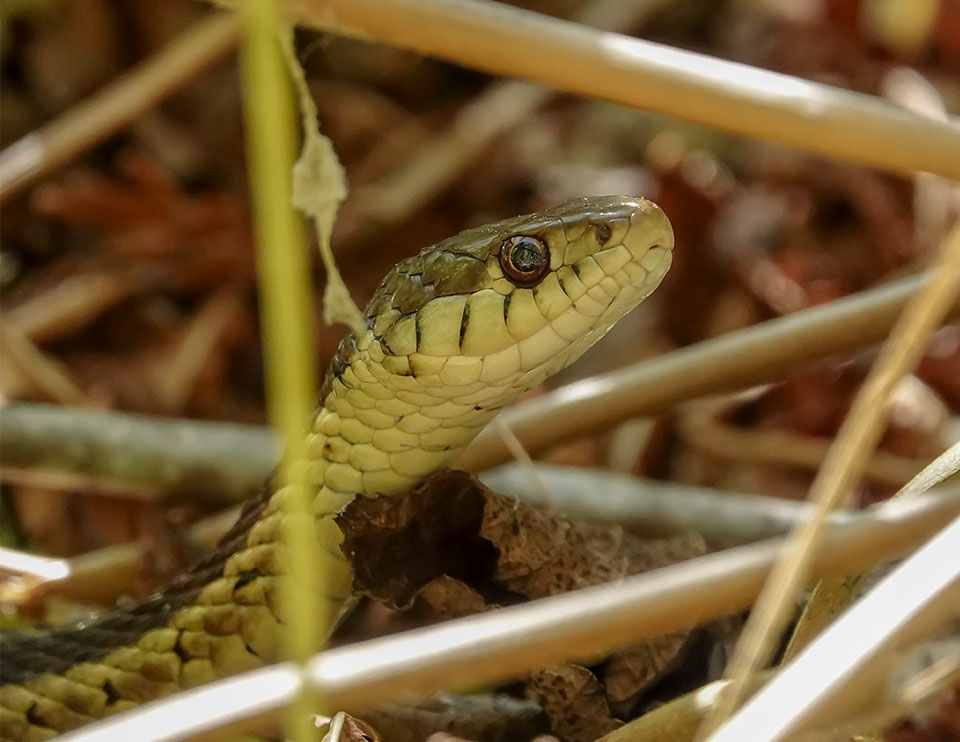
One of the most commonly seen and widely distributed snakes in the Adirondack region is the Common Gartersnake (Thamnophis sirtalis). A small to medium-sized snake, the Common Gartersnake is found across the North American continent. There are currently 13 recognized subspecies; ours is the Eastern Gartersnake (T.s. sirtalis). The appearance of this snake is somewhat variable. They come in a wide range of colors; most have three light-colored stripes (usually yellow) on a darker background that is usually dark brown, but may be black, green, or olive. The underside may be yellow, green, or white.
Common Gartersnakes eat mainly amphibians and earthworms. They also prey on slugs, insects, small fish, nestling birds, and small mammals, such as rodents. As with most snakes, Common Gartersnakes locate their prey through their sense of smell, using their forked tongues to locate and follow scent trails. Common Gartersnakes grab and swallow their prey and may also use saliva, which is toxic to amphibians and other small animals, to incapacitate their prey. The bite of Common Gartersnakes, however, reportedly is not dangerous to humans.
Common Gartersnakes are habitat generalists. They are at home in forests, old fields, meadows, marshes and other wetlands, and urban and suburban settings. They are often found near ponds, lakes, and streams. Common Gartersnakes go into dormancy during the winter, often spending the colder months in groups of just a few or many hundreds. Wintering sites include house foundations, mammal burrows, and rocky crevices. They emerge in the first warm days of spring.
The Smooth Greensnake (Opheodrys vernalis) is another nonvenomous snake found in the Adirondack Park, although it is much less abundant than the Common Gartersnake. A small to medium-sized snake usually measuring 14 to 20 inches in length, the Smooth Greensnake (as the name implies) is green, with bright emerald green sides and back and a creamy white or yellowish belly. Its tongue is red, tipped in black.
The Smooth Greensnake, like all snakes, is a carnivore. It prefers soft-bodies invertebrates, such as moth and butterfly larvae. Its menu includes spiders, millipedes, centipedes, crickets, ants, snails, worms, and slugs. Smoothgreen Snakes may burrow into soil and decaying woody debris in search of their prey.
The Smooth Greensnake is found in a variety of habitats, but prefers green areas for camouflage, such as meadows, old fields, and the wet grassy areas that border forests. Smooth Greensnakes are active from early May through late September in New York State, spending the rest of the year below ground, often in rodent burrows and the below-ground chambers of ant mounds.
List of Adirondack Amphibians & Reptiles
References
New York State Department of Environmental Conservation. Amphibians & Reptiles. Retrieved 23 February 2025.
New York State Department of Environmental Conservation. New York State Amphibian and Reptile Atlas Project. Species of Salamanders Found in New York. Retrieved 23 February 2025.
New York State Department of Environmental Conservation. New York State Amphibian and Reptile Atlas Project. Species of Toads and Frogs Found in New York. Retrieved 23 February 2025.
New York State Department of Environmental Conservation. New York State Amphibian and Reptile Atlas Project. Species of Turtles Found in New York. Retrieved 23 February 2025.
New York State Department of Environmental Conservation. New York State Amphibian and Reptile Atlas Project. Species of Lizards and Snakes Found in New York. Retrieved 23 February 2025.
New York State Department of Environmental Conservation. New York Nature Explorer. Retrieved 23 February 2025.
iNaturalist. Amphibians. Class Amphibia. Retrieved 23 February 2025.
iNaturalist. Frogs and Toads. Order Anura. Retrieved 23 February 2025.
iNaturalist. Reptiles. Class Reptilia. Retrieved 23 February 2025.
iNaturalist. Snakes. Suborder Serpentes. Retrieved 23 February 2025.
iNaturalist. Turtles and Tortoises. Order Testudines. Retrieved 23 February 2025.
iNaturalist. Adirondack Park Sightings. Amphibians. Class Amphibia. Retrieved 23 February 2025.
iNaturalist. Adirondack Park Sightings. Reptiles. Class Reptilia. Retrieved 23 February 2025.
State University of New York. College of Environmental Science and Forestry. Adirondack Amphibians and Reptiles. Retrieved 23 February 2025.
State University of New York. College of Environmental Science and Forestry. Frogs and Toads of New York. Retrieved 23 February 2025.
State University of New York. College of Environmental Science and Forestry. Salamanders of New York. Retrieved 23 February 2025.
State University of New York. College of Environmental Science and Forestry. Snakes of New York. Retrieved 23 February 2025.
State University of New York. College of Environmental Science and Forestry. Turtles of New York. Retrieved 23 February 2025.
Integrated Taxonomic Information System On-line Database. Retrieved 23 February 2025.
United States Environmental Protection Agency. Wildlife Exposure Factors Handbook. Office of Research and Development. EPA/600/R-93/187 (December 1993). Retrieved 23 February 2025.
Society for the Study of Amphibians and Reptiles. SSAR North American Species Names Database. Retrieved 23 February 2025.
David B. Wake and Michelle S. Koo, "Amphibians," Current Biology, Volume 28, Issue 21, (5 November 2018), pp. R1237-R1241. Retrieved 23 February 2025. .
Richard Shine, "Reptiles," Current Biology, Volume 23, Issue 6, (18 March 2013), pp. R227-R231. Retrieved 23 February 2025.
New York State. Department of Environmental Conservation. New York Natural Heritage Program. Ecological Communities of New York State. Second Edition (March 2014). Retrieved 23 February 2025.
Elizabeth H. Thompson and Eric R. Sorenson. Wetland, Woodland, Wildland: A Guide to the Natural Communities of Vermont (University Press of New England, 2000). Retrieved 23 February 2025.
Malcolm L. Hunter Jr., John Albright, and Jane Arbuckle, Eds. The Amphibians and Reptiles of Maine. Maine Agricultural Experiment Station. Bulletin 838 (1992). Retrieved 23 February 2025.
Virginia Herpetological Society. Retrieved 23 February 2025.
Bernard S. Martof, William M. Palmer, Joseph R. Railey, and Jack Dermid. Amphibians & Reptiles of the Carolinas & Virginia. (University of North Carolina Press, 1980. Retrieved 23 February 2025.
AmphibiaWeb. 2020. University of California, Berkeley, CA, USA. Database. Retrieved 23 February 2025.
C. Kenneth Dodd Jr. Frogs of the United States and Canada. (Johns Hopkins University Press, 2013). Retrieved 23 February 2025.
Robert Powell, Roger Conant and Joseph T. Collins. A Field Guide to Reptiles and Amphibians: Eastern and Central North America. Fourth Edition (Houghton Mifflin Harcourt, 2016).
Hobart M. Smith and Edmund D. Brodie. Reptiles of North America: A Guide to Field Identification (Western Publishing Company, 1982).
Alexander C. Martin, Herbert S. Zim, and Arnold L. Nelson. American Wildlife & Plants. A Guide to Wildlife Food Habits (Dover Publications, 1951), pp. 278-283. Retrieved 23 February 2025.
John Eastman. The Book of Swamp and Bog: Trees, Shrubs, and Wildflowers of Eastern Freshwater Wetlands (Stackpole Books, 1995).
John Eastman. The Book of Forest and Thicket: Trees, Shrubs, and Wildflowers of Eastern North America (Stackpole Books, 1992).
Iowa State University. BugGuide. Retrieved 23 February 2025.
James P. Gibbs, Alvin R. Breisch, Peter K. Ducey, Glenn Johnson, John L. Behler, Richard C. Bothner. The Amphibians and Reptiles of New York State. Identification, Natural History, and Conservation (Oxford University Press, 2007).
James M. Ryan. Adirondack Wildlife. A Field Guide (University of New Hampshire Press, 2008), pp. 94-112.
Arthur C. Hulse. Amphibians and Reptiles of Pennsylvania and the Northeast (Cornell University Press, 2001).
James H. Harding and David A Mifsud. Amphibians and Reptiles of the Great Lakes Region. Revised Edition (University of Michigan Press, 2017).
Richard M. DeGraaf and Mariko Yamasaki. New England Wildlife: Habitat, Natural History, and Distribution (University Press of New England, 2001), pp. 23-74, 396-399, 423-426. Retrieved 23 February 2025.
Richard M. DeGraaf and Deborah Rudis. Forest Habitat for Reptiles & Amphibians of the Northeast (US Department of Agriculture. Forest Service, 1981). Retrieved 23 February 2025.
Lang Elliott, Carl Gerhardt, and Carlos Davidson. The Frogs and Toads of North America: A Comprehensive Guide to Their Identification, Behavior, and Calls (Houghton Mifflin Harcourt, 2009). Retrieved 23 February 2025.
John L. Behler and F. Wayne King. National Audubon Society Field Guide to North American Reptiles and Amphibians (Alfred A. Knopf, 1998).
Thomas F. Tyning. A Guide to Amphibians and Reptiles (Little, Brown and Company, 1990). Retrieved 23 February 2025.
Mary C. Dickerson. The Frog Book: North American Toads and Frogs, with a Study of the Habits and Life Histories of Those of the Northeastern States (Doubleday, Page and Company, 1906). Retrieved 23 February 2025.
James W. Petranka. Salamanders of the United States and Canada (Smithsonian Institution Press, 1998). Retrieved 23 February 2025.
Sherman C. Bishop. Handbook of Salamanders: The Salamanders of the United States, of Canada, and of Lower California (Cornell University Press, 1994).
Mark O'Shea and Tim Halliday. Reptiles and Amphibians (Dorling Kindersley Limited, 2001). Retrieved 23 February 2025.
Cornell Lab of Ornithology, Ithaca, New York. Birds of North America. Subscription Web Site. Retrieved 23 February 2025.
Ontario Nature. Reptile and Amphibian Field Guide. Retrieved 23 February 2025.
Carl H. Ernst and Jeffrey E. Lovich. Turtles of the United States and Canada. Second Edition. (Johns Hopkins University Press, 2009).
Carl H. Ernst and Roger William Barbour. Turtles of the World (Smithsonian Institution Press, 1989). Retrieved 23 February 2025.
Carl H. Ernst and Roger William Barbour. Turtles of the United States (The University Press of Kentucky, 1972). Retrieved 23 February 2025.
Archie Fairly Carr. Handbook of Turtles. The Turtles of the United States, Canada, and Baja California (Comstock Pub. Associates, 1952).
Carl H. Ernst and Evelyn M Ernst. Snakes of the United States and Canada (Smithsonian Books, 2003). Retrieved 23 February 2025.
Albert Hazen Wright and Anna Allen Wright. Handbook of Snakes of the United States and Canada. Volume 2 (Cornell University Press, 1957). Retrieved 23 February 2025.
